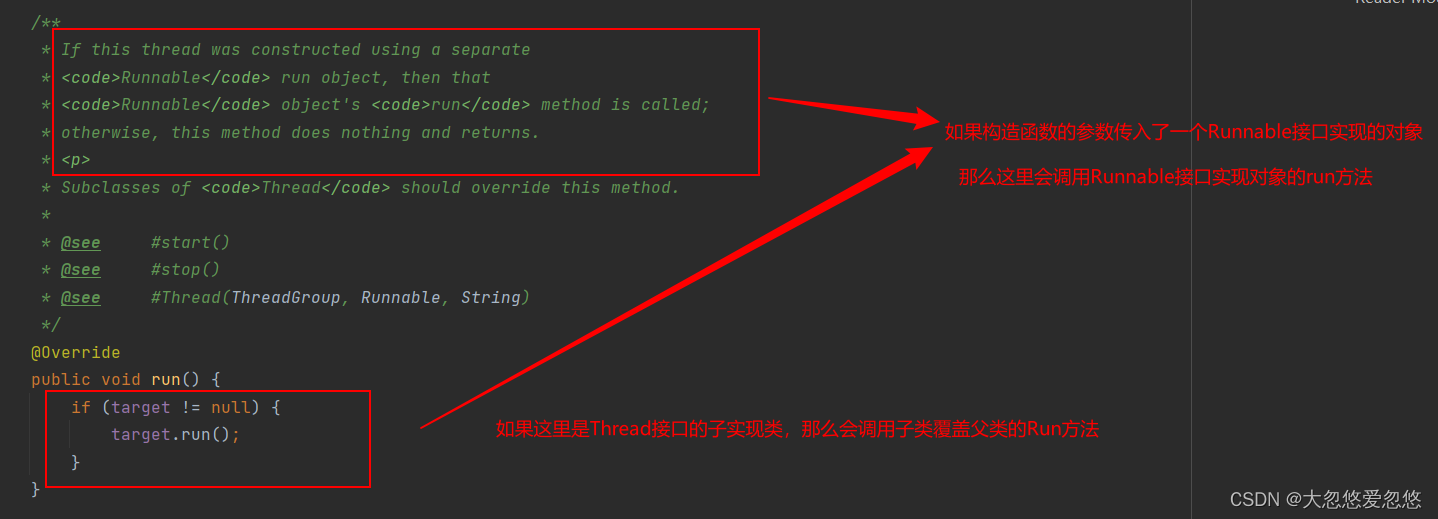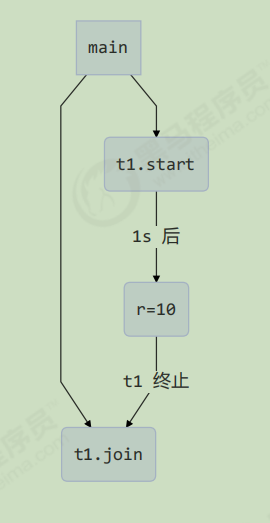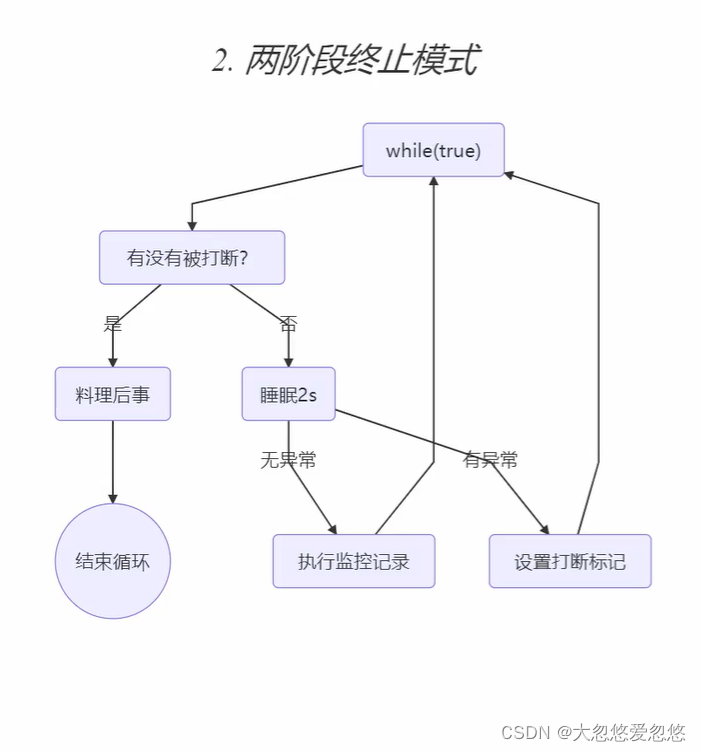内容导读:
- 创建和运行线程
- 查看线程
- 线程 API
- 线程状态
Java 线程
方法一,直接使用 Thread
// 创建线程对象
Thread t = new Thread() {
public void run() {
// 要执行的任务
}
};
// 启动线程
t.start()
example:
// 构造方法的参数是给线程指定名字,推荐
Thread t1 = new Thread("t1") {
@Override
// run 方法内实现了要执行的任务
public void run() {
log.debug("hello");
}
};
t1.start();
输出
19:19:00 [t1] c.ThreadStarter - hello
方法二,使用 Runnable 配合 Thread
把【线程】和【任务】(要执行的代码)分开
- Thread 代表线程
- Runnable 可运行的任务(线程要执行的代码)
Runnable runnable = new Runnable() {
public void run(){
// 要执行的任务
}
};
// 创建线程对象
Thread t = new Thread( runnable );
// 启动线程
t.start();
example:
// 创建任务对象
Runnable task2 = new Runnable() {
@Override
public void run() {
log.debug("hello");
}
};
// 参数1 是任务对象; 参数2 是线程名字,推荐
Thread t2 = new Thread(task2, "t2");
t2.start();
输出
19:19:00 [t2] c.ThreadStarter - hello
Java 8 以后可以使用 lambda 精简代码
// 创建任务对象
Runnable task2 = () -> log.debug("hello");
// 参数1 是任务对象; 参数2 是线程名字,推荐
Thread t2 = new Thread(task2, "t2");
t2.start();
原理之 Thread 与 Runnable 的关系
分析 Thread 的源码,理清它与 Runnable 的关系

小结
方法1 是把线程和任务合并在了一起,方法2 是把线程和任务分开了
- 用 Runnable 更容易与线程池等高级 API 配合
- 用 Runnable 让任务类脱离了 Thread 继承体系,更灵活
方法三,FutureTask 配合 Thread
FutureTask 能够接收 Callable 类型的参数,用来处理有返回结果的情况
FutureTask本质就是继承了Runnable接口和Future接口,Future接口提供了很多额外的特性:
public interface Future<V> {
/**
* Attempts to cancel execution of this task. This attempt will
* fail if the task has already completed, has already been cancelled,
* or could not be cancelled for some other reason. If successful,
* and this task has not started when {@code cancel} is called,
* this task should never run. If the task has already started,
* then the {@code mayInterruptIfRunning} parameter determines
* whether the thread executing this task should be interrupted in
* an attempt to stop the task.
*
* <p>After this method returns, subsequent calls to {@link #isDone} will
* always return {@code true}. Subsequent calls to {@link #isCancelled}
* will always return {@code true} if this method returned {@code true}.
*
* @param mayInterruptIfRunning {@code true} if the thread executing this
* task should be interrupted; otherwise, in-progress tasks are allowed
* to complete
* @return {@code false} if the task could not be cancelled,
* typically because it has already completed normally;
* {@code true} otherwise
*/
boolean cancel(boolean mayInterruptIfRunning);
/**
* Returns {@code true} if this task was cancelled before it completed
* normally.
*
* @return {@code true} if this task was cancelled before it completed
*/
boolean isCancelled();
/**
* Returns {@code true} if this task completed.
*
* Completion may be due to normal termination, an exception, or
* cancellation -- in all of these cases, this method will return
* {@code true}.
*
* @return {@code true} if this task completed
*/
boolean isDone();
/**
* Waits if necessary for the computation to complete, and then
* retrieves its result.
*
* @return the computed result
* @throws CancellationException if the computation was cancelled
* @throws ExecutionException if the computation threw an
* exception
* @throws InterruptedException if the current thread was interrupted
* while waiting
*/
V get() throws InterruptedException, ExecutionException;
/**
* Waits if necessary for at most the given time for the computation
* to complete, and then retrieves its result, if available.
*
* @param timeout the maximum time to wait
* @param unit the time unit of the timeout argument
* @return the computed result
* @throws CancellationException if the computation was cancelled
* @throws ExecutionException if the computation threw an
* exception
* @throws InterruptedException if the current thread was interrupted
* while waiting
* @throws TimeoutException if the wait timed out
*/
V get(long timeout, TimeUnit unit)
throws InterruptedException, ExecutionException, TimeoutException;
}
使用演示:
// 创建任务对象
FutureTask<Integer> task3 = new FutureTask<>(() -> {
log.debug("hello");
return 100;
});
// 参数1 是任务对象; 参数2 是线程名字,推荐
new Thread(task3, "t3").start();
// 主线程阻塞,同步等待 task 执行完毕的结果
Integer result = task3.get();
log.debug("结果是:{}", result);
输出
19:22:27 [t3] c.ThreadStarter - hello
19:22:27 [main] c.ThreadStarter - 结果是:100
查看进程线程的方法
windows
- 任务管理器可以查看进程和线程数,也可以用来杀死进程
- tasklist 查看进程
- taskkill 杀死进程


Java
- jps 命令查看所有 Java 进程
- jstack 查看某个 Java 进程(PID)的所有线程状态
- jconsole 来查看某个 Java 进程中线程的运行情况(图形界面)


linux
- ps -fe 查看所有进程
- ps -fT -p 查看某个进程(PID)的所有线程
- kill 杀死进程
- top 按大写 H 切换是否显示线程
- top -H -p 查看某个进程(PID)的所有线程
jconsole 远程监控配置
- 需要以如下方式运行你的 java 类
java -Djava.rmi.server.hostname=`ip地址` -Dcom.sun.management.jmxremote -
Dcom.sun.management.jmxremote.port=`连接端口` -Dcom.sun.management.jmxremote.ssl=是否安全连接 -
Dcom.sun.management.jmxremote.authenticate=是否认证 java类
- 修改 /etc/hosts 文件将 127.0.0.1 映射至主机名
- 如果要认证访问,还需要做如下步骤
复制 jmxremote.password 文件
修改 jmxremote.password 和 jmxremote.access 文件的权限为 600 即文件所有者可读写
连接时填入 controlRole(用户名),R&D(密码)
线程运行原理
栈与栈帧
Java Virtual Machine Stacks (Java 虚拟机栈)
我们都知道 JVM 中由堆、栈、方法区所组成,其中栈内存是给谁用的呢?
其实就是线程,每个线程启动后,虚拟机就会为其分配一块栈内存。
每个栈由多个栈帧(Frame)组成,对应着每次方法调用时所占用的内存
每个线程只能有一个活动栈帧,对应着当前正在执行的那个方法

栈帧图解

多线程

并且主线程的临时线程是不同的栈,即各自有各自的栈,来存放各自的栈帧(方法运行)
总结:每个线程有自己独立的栈内存,里面有多个栈帧,他们之间互不干扰,当所有线程执行完毕,程序结束
线程上下文切换(Thread Context Switch)
因为以下一些原因导致 cpu 不再执行当前的线程,转而执行另一个线程的代码
- 线程的 cpu 时间片用完
- 垃圾回收
- 有更高优先级的线程需要运行
- 线程自己调用了 sleep、yield、wait、join、park、synchronized、lock 等方法
当 Context Switch 发生时,需要由操作系统保存当前线程的状态,并恢复另一个线程的状态,Java 中对应的概念
就是程序计数器(Program Counter Register),它的作用是记住下一条 jvm 指令的执行地址,是线程私有的
- 状态包括程序计数器、虚拟机栈中每个栈帧的信息,如局部变量、操作数栈、返回地址等
-
Context Switch 频繁发生会影响性能

常用方法



start 与 run
调用 run
public static void main(String[] args) {
Thread t1 = new Thread("t1") {
@Override
public void run() {
log.debug(Thread.currentThread().getName());
FileReader.read(Constants.MP4_FULL_PATH);
}
};
t1.run();
log.debug("do other things ...");
}
输出
19:39:14 [main] c.TestStart - main
19:39:14 [main] c.FileReader - read [1.mp4] start ...
19:39:18 [main] c.FileReader - read [1.mp4] end ... cost: 4227 ms
19:39:18 [main] c.TestStart - do other things ...
程序仍在 main 线程运行, FileReader.read() 方法调用还是同步的
调用 start
将上述代码的 t1.run() 改为
t1.start();
输出
19:41:30 [main] c.TestStart - do other things ...
19:41:30 [t1] c.TestStart - t1
19:41:30 [t1] c.FileReader - read [1.mp4] start ...
19:41:35 [t1] c.FileReader - read [1.mp4] end ... cost: 4542 ms
程序在 t1 线程运行, FileReader.read() 方法调用是异步的
小结
- 直接调用 run 是在主线程中执行了 run,没有启动新的线程
- 使用 start 是启动新的线程,通过新的线程间接执行 run 中的代码
sleep 与 yield
sleep
- 调用 sleep 会让当前线程从 Running 进入 Timed Waiting 状态(阻塞)
- 其它线程可以使用 interrupt 方法打断正在睡眠的线程,这时 sleep 方法会抛出 InterruptedException
- 睡眠结束后的线程未必会立刻得到执行
- 建议用 TimeUnit 的 sleep 代替 Thread 的 sleep 来获得更好的可读性

yield
- 调用 yield 会让当前线程从 Running 进入 Runnable 就绪状态,然后调度执行其它线程
- 具体的实现依赖于操作系统的任务调度器
让出当前cpu使用权,注意如果在让出cpu使用权时,此时没有其他线程需要执行,那么任务调度器会把cpu时间片分给这个线程,即继续执行当前yield的线程
任务调度器不会把时间片分给处于阻塞(休眠状态的线程)
线程优先级
- 线程优先级会提示(hint)调度器优先调度该线程,但它仅仅是一个提示,调度器可以忽略它
- 如果 cpu 比较忙,那么优先级高的线程会获得更多的时间片,但 cpu 闲时,优先级几乎没作用
数字越大,优先级越高
Runnable task1 = () -> {
int count = 0;
for (;;) {
System.out.println("---->1 " + count++);
}
};
Runnable task2 = () -> {
int count = 0;
for (;;) {
// Thread.yield();
System.out.println(" ---->2 " + count++);
}
};
Thread t1 = new Thread(task1, "t1");
Thread t2 = new Thread(task2, "t2");
// t1.setPriority(Thread.MIN_PRIORITY);
// t2.setPriority(Thread.MAX_PRIORITY);
t1.start();
t2.start();
应用:sleep方法来限制cpu的使用
在没有利用 cpu 来计算时,不要让 while(true) 空转浪费 cpu,这时可以使用 yield 或 sleep 来让出 cpu 的使用权给其他程序
while(true) {
try {
Thread.sleep(50);
} catch (InterruptedException e) {
e.printStackTrace();
}
}
- 可以用 wait 或 条件变量达到类似的效果
- 不同的是,后两种都需要加锁,并且需要相应的唤醒操作,一般适用于要进行同步的场景
- sleep 适用于无需锁同步的场景
join 方法详解
为什么需要 join
下面的代码执行,打印 r 是什么?
static int r = 0;
public static void main(String[] args) throws InterruptedException {
test1();
}
private static void test1() throws InterruptedException {
log.debug("开始");
Thread t1 = new Thread(() -> {
log.debug("开始");
sleep(1);
log.debug("结束");
r = 10;
});
t1.start();
log.debug("结果为:{}", r);
log.debug("结束");
}
分析
- 因为主线程和线程 t1 是并行执行的,t1 线程需要 1 秒之后才能算出 r=10
- 而主线程一开始就要打印 r 的结果,所以只能打印出 r=0
解决方法
- 用 sleep 行不行?为什么?----不知道确切的子线程结束时间,不太好把握
- 用 join,加在 t1.start() 之后即可
join()等待线程运行结束
join应用之同步
以调用方角度来讲,如果
- 需要等待结果返回,才能继续运行就是同步
- 不需要等待结果返回,就能继续运行就是异步

等待多个结果
问,下面代码 cost 大约多少秒?
static int r1 = 0;
static int r2 = 0;
public static void main(String[] args) throws InterruptedException {
test2();
}
private static void test2() throws InterruptedException {
Thread t1 = new Thread(() -> {
sleep(1);
r1 = 10;
});
Thread t2 = new Thread(() -> {
sleep(2);
r2 = 20;
});
long start = System.currentTimeMillis();
t1.start();
t2.start();
t1.join();
t2.join();
long end = System.currentTimeMillis();
log.debug("r1: {} r2: {} cost: {}", r1, r2, end - start);
}
分析如下
- 第一个 join:等待 t1 时, t2 并没有停止, 而在运行
- 第二个 join:1s 后, 执行到此, t2 也运行了 1s, 因此也只需再等待 1s
如果颠倒两个 join 呢?
最终都是输出
20:45:43.239 [main] c.TestJoin - r1: 10 r2: 20 cost: 2005

有时效的 join
等够时间
static int r1 = 0;
static int r2 = 0;
public static void main(String[] args) throws InterruptedException {
test3();
}
public static void test3() throws InterruptedException {
Thread t1 = new Thread(() -> {
sleep(1);
r1 = 10;
});
long start = System.currentTimeMillis();
t1.start();
// 线程执行结束会导致 join 结束
t1.join(1500);
long end = System.currentTimeMillis();
log.debug("r1: {} r2: {} cost: {}", r1, r2, end - start);
}
输出
20:48:01.320 [main] c.TestJoin - r1: 10 r2: 0 cost: 1010
没等够时间
static int r1 = 0;
static int r2 = 0;
public static void main(String[] args) throws InterruptedException {
test3();
}
public static void test3() throws InterruptedException {
Thread t1 = new Thread(() -> {
sleep(2);
r1 = 10;
});
long start = System.currentTimeMillis();
t1.start();
// 线程执行结束会导致 join 结束
t1.join(1500);
long end = System.currentTimeMillis();
log.debug("r1: {} r2: {} cost: {}", r1, r2, end - start);
}
输出
20:52:15.623 [main] c.TestJoin - r1: 0 r2: 0 cost: 1502
interrupt 方法详解
打断 sleep,wait,join 的线程
这几个方法都会让线程进入阻塞状态
打断 sleep 的线程, 会清空打断状态,以 sleep 为例
private static void test1() throws InterruptedException {
Thread t1 = new Thread(()->{
sleep(1);
}, "t1");
t1.start();
sleep(0.5);
t1.interrupt();
log.debug(" 打断状态: {}", t1.isInterrupted());
}
输出
java.lang.InterruptedException: sleep interrupted
at java.lang.Thread.sleep(Native Method)
at java.lang.Thread.sleep(Thread.java:340)
at java.util.concurrent.TimeUnit.sleep(TimeUnit.java:386)
at cn.itcast.n2.util.Sleeper.sleep(Sleeper.java:8)
at cn.itcast.n4.TestInterrupt.lambda$test1$3(TestInterrupt.java:59)
at java.lang.Thread.run(Thread.java:745)
21:18:10.374 [main] c.TestInterrupt - 打断状态: false
对于阻塞线程而言,如果他们在阻塞过程中,有别的线程想要对阻塞线程进行打断操作,那么他们会用抛出异常的方式进行打断处理,因此会将打断标记置为false
打断正常运行的线程
打断正常运行的线程, 不会清空打断状态

private static void test2() throws InterruptedException {
Thread t2 = new Thread(()->{
while(true) {
Thread current = Thread.currentThread();
boolean interrupted = current.isInterrupted();
if(interrupted) {
log.debug(" 打断状态: {}", interrupted);
break;
}
}
}, "t2");
t2.start();
sleep(0.5);
t2.interrupt();
}
输出
20:57:37.964 [t2] c.TestInterrupt - 打断状态: true
设计模式之两阶段终止模式
Two Phase Termination
在一个线程 T1 中如何“优雅”终止线程 T2?这里的【优雅】指的是给 T2 一个料理后事的机会。
1. 错误思路
使用线程对象的 stop() 方法停止线程
stop 方法会真正杀死线程,如果这时线程锁住了共享资源,那么当它被杀死后就再也没有机会释放锁,
其它线程将永远无法获取锁
使用 System.exit(int) 方法停止线程
目的仅是停止一个线程,但这种做法会让整个程序都停止
2. 两阶段终止模式

利用 isInterrupted
interrupt 可以打断正在执行的线程,无论这个线程是在 sleep,wait,还是正常运行
但是不会清除打断的标记
class TPTInterrupt {
private Thread thread;
public void start(){
thread = new Thread(() -> {
while(true) {
Thread current = Thread.currentThread();
if(current.isInterrupted()) {
log.debug("料理后事");
break;
}
try {
Thread.sleep(1000);
log.debug("将结果保存");
} catch (InterruptedException e) {
//sleep方法抛出异常,并且会清空打断标记,因此我们这里在抛出异常后,需要手动再设置一下打断标记为true
current.interrupt();
}
// 执行监控操作
}
},"监控线程");
thread.start();
}
public void stop() {
thread.interrupt();
}
}
调用
TPTInterrupt t = new TPTInterrupt();
t.start();
Thread.sleep(3500);
log.debug("stop");
t.stop();
结果
11:49:42.915 c.TwoPhaseTermination [监控线程] - 将结果保存
11:49:43.919 c.TwoPhaseTermination [监控线程] - 将结果保存
11:49:44.919 c.TwoPhaseTermination [监控线程] - 将结果保存
11:49:45.413 c.TestTwoPhaseTermination [main] - stop
11:49:45.413 c.TwoPhaseTermination [监控线程] - 料理后事
打断 park 线程
park方法会阻塞当前线程执行
LockSupport.park();
打断 park 线程, 不会清空打断状态
private static void test3() throws InterruptedException {
Thread t1 = new Thread(() -> {
log.debug("park...");
LockSupport.park();
log.debug("unpark...");
log.debug("打断状态:{}", Thread.currentThread().isInterrupted());
}, "t1");
t1.start();
sleep(0.5);
t1.interrupt();
}
输出
21:11:52.795 [t1] c.TestInterrupt - park...
21:11:53.295 [t1] c.TestInterrupt - unpark...
21:11:53.295 [t1] c.TestInterrupt - 打断状态:true
如果打断标记已经是 true, 则 park 会失效
private static void test4() {
Thread t1 = new Thread(() -> {
for (int i = 0; i < 5; i++) {
log.debug("park...");
LockSupport.park();
log.debug("打断状态:{}", Thread.currentThread().isInterrupted());
}
});
t1.start();
sleep(1);
t1.interrupt();
}
输出
21:13:48.783 [Thread-0] c.TestInterrupt - park...
21:13:49.809 [Thread-0] c.TestInterrupt - 打断状态:true
21:13:49.812 [Thread-0] c.TestInterrupt - park...
21:13:49.813 [Thread-0] c.TestInterrupt - 打断状态:true
21:13:49.813 [Thread-0] c.TestInterrupt - park...
21:13:49.813 [Thread-0] c.TestInterrupt - 打断状态:true
21:13:49.813 [Thread-0] c.TestInterrupt - park...
21:13:49.813 [Thread-0] c.TestInterrupt - 打断状态:true
21:13:49.813 [Thread-0] c.TestInterrupt - park...
21:13:49.813 [Thread-0] c.TestInterrupt - 打断状态:true
提示
可以使用 Thread.interrupted() 清除打断状态,interrupted()打断当前线程,并清空打断状态
总结:在打断标记为false的情况下,park()方法会阻塞当前线程;在打断标记为true的情况下,park()方法不会阻塞当前线程
不推荐使用的方法
还有一些不推荐使用的方法,这些方法已过时,容易破坏同步代码块,造成线程死锁

主线程与守护线程
默认情况下,Java 进程需要等待所有线程都运行结束,才会结束。有一种特殊的线程叫做守护线程,只要其它非守护线程运行结束了,即使守护线程的代码没有执行完,也会强制结束
例:
log.debug("开始运行...");
Thread t1 = new Thread(() -> {
log.debug("开始运行...");
sleep(2);
log.debug("运行结束...");
}, "daemon");
// 设置该线程为守护线程
t1.setDaemon(true);
t1.start();
sleep(1);
log.debug("运行结束...");
输出
08:26:38.123 [main] c.TestDaemon - 开始运行...
08:26:38.213 [daemon] c.TestDaemon - 开始运行...
08:26:39.215 [main] c.TestDaemon - 运行结束...
注意
- 垃圾回收器线程就是一种守护线程
- Tomcat 中的 Acceptor 和 Poller 线程都是守护线程,所以 Tomcat 接收到 shutdown命令后,不会等 待它们处理完当前请求
说法一: 线程的五种状态
这是从 操作系统 层面来描述的

- 【初始状态】仅是在语言层面创建了线程对象,还未与操作系统线程关联
- 【可运行状态】(就绪状态)指该线程已经被创建(与操作系统线程关联),可以由 CPU 调度执行
- 【运行状态】指获取了 CPU 时间片运行中的状态
当 CPU 时间片用完,会从【运行状态】转换至【可运行状态】,会导致线程的上下文切换
- 【阻塞状态】
如果调用了阻塞 API,如 BIO 读写文件,这时该线程实际不会用到 CPU,会导致线程上下文切换,进入【阻塞状态】 等 BIO
操作完毕,会由操作系统唤醒阻塞的线程,转换至【可运行状态】
与【可运行状态】的区别是,对【阻塞状态】的线程来说只要它们一直不唤醒,调度器就一直不会考虑 调度它们
- 【终止状态】表示线程已经执行完毕,生命周期已经结束,不会再转换为其它状态
说法二: 六种状态
这是从 Java API 层面来描述的
根据 Thread.State 枚举,分为六种状态

-
NEW线程刚被创建,但是还没有调用 start() 方法 -
RUNNABLE当调用了 start() 方法之后,注意,Java API 层面的RUNNABLE状态涵盖了 操作系统层面的 【可运行状态】、【运行状态】和【阻塞状态】(由于 BIO 导致的线程阻塞,在 Java 里无法区分,仍然认为 是可运行) -
BLOCKED , WAITING , TIMED_WAITING都是 Java API层面对【阻塞状态】的细分,后面会在状态转换一节 详述 -
TERMINATED当线程代码运行结束

总结
- 线程创建
- 线程重要 api,如 start,run,sleep,join,interrupt 等
- 线程状态
- 应用方面
异步调用:主线程执行期间,其它线程异步执行耗时操作
提高效率:并行计算,缩短运算时间
同步等待:join
统筹规划:合理使用线程,得到最优效果
- 原理方面
线程运行流程:栈、栈帧、上下文切换、程序计数器
Thread 两种创建方式 的源码
- 模式方面
终止模式之两阶段终止